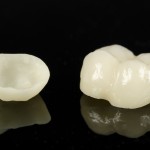
Improvements in dental ceramic materials in the past decade has led to the increasing use of all ceramic crowns on posterior teeth. The aim of this study was to evaluate the clinical fracture incidence of tooth-supported all-ceramic crowns according to restored tooth type.
The authors searched the Medline/PubMed, Embase, the Cochrane Library, the Chinese Biomedical Literature Database, and the China National Knowledge Infrastructure. They also searched recent issues of 11 dental journals and the bibliographies of identified articles. Title and abstracts were independently screened by two reviewers with Clinical randomized controlled trials (RCTs), prospective cohort studies and and retrospective studies being included. Studies with mean follow-up periods of less than 36 months were excluded. Fractures were classified as veneer fractures or core fractures)
- 37 studies were included (2 RCTs, 25 prospective cohorts, 10 retrospective)
- Follow-up periods ranged from 36-97 months.
- The annual overall fracture rate of 1.6% irrespective of the materials used, translating into a 5-year fracture incidence of 7.7%.
- The posterior segment demonstrated a significantly higher annual fracture rate than the anterior segment (posterior: 2.1% vs anterior: 0.9%, P < .001).
- Molars showed the highest annual fracture rate of 3.0%, while the incidence dropped to 1.1% for premolars, 1.2% for canines, and 0.7% for incisors.
- For core fracture rate the annual incidence of 1.5%, translating into a 5-year fracture rate of 7.2%.
- The highest annual core fracture incidence was associated with molars (2.7%); rates in premolar, canine, and incisor were comparable with annual core fracture incidences of 0.9%, 0.8%, and 0.6%, respectively.
- For veneer fracture, the overall annual incidence dropped to only 0.6%, with a 5-year rate of 3.0%.
- Anterior (0.4%) and posterior (0.5%) crowns were found to have comparable annual clinical incidences of veneer fracture.
The Authors concluded
Within the limitations of this study’s protocol, the current evidence was interpreted to suggest that dental ceramic materials demonstrated acceptable 5-year core and veneer fracture incidences when used for tooth-supported single crowns in both anterior and posterior segments. A higher fracture rate for posterior crowns was the clear trend for single crowns, and molar crowns showed a significantly higher fracture rate than premolar crowns.
Links
Wang X, Fan D, Swain MV, Zhao K. A systematic review of all-ceramic crowns: clinical fracture rates in relation to restored tooth type. Int J Prosthodont. 2012 Sep-Oct;25(5):441-50. PubMed PMID: 22930765.
